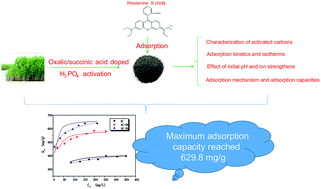Ultra-high Rhodamine B adsorption capacities from an aqueous solution by activated carbon derived from Phragmites australis doped with organic acid by phosphoric acid activation†
Abstract
This study shows that oxalic acid (OA) and succinic acid (SA) were employed to modify Phragmites australis (PA)-based activated carbons (ACs) during phosphoric acid activation to improve Rhodamine B (RhB) removal from aqueous solutions. This study shows that oxalic acid (OA) and succinic acid (SA) were employed to modify Phragmites australis (PA)-based activated carbons (ACs) during phosphoric acid activation to improve Rhodamine B (RhB) removal from aqueous solutions. The unmodified activated carbon (AC), OA-modified and SA-modified ACs (AC-OA and AC-SA) were characterized by N2 adsorption/desorption, Boehm's titration, pHpzc and FT-IR analysis. It was found that the BET surface area of AC-OA (1040.36 m2 g−1) and AC-SA (1775.01 m2 g−1) was larger than unmodified AC (745.68 m2 g−1). In addition, AC-OA (2.987 mmol g−1) and AC-SA (3.194 mmol g−1) exhibited dramatically higher surface acidity than AC (1.852 mmol g−1). The RhB adsorption capacities of ACs were further investigated at different contact times, pHs, and ionic strengths. The adsorption equilibrium data of ACs were properly fitted to the Langmuir model. The kinetic studies show that the adsorption of RhB proceeds according to the pseudo-second order kinetics. The maximum RhB adsorption capacities of AC-OA (550.9 mg g−1) and AC-SA (629.8 mg g−1) were significantly higher than that of AC (417.1 mg g−1) due to their larger BET surface areas. Higher RhB adsorption could be attributed to their surface acidic functional groups.


 Please wait while we load your content...
Please wait while we load your content...